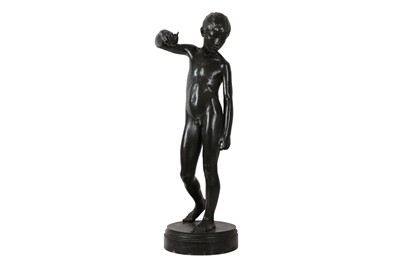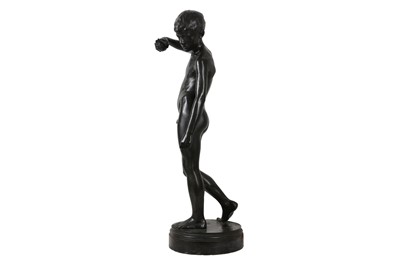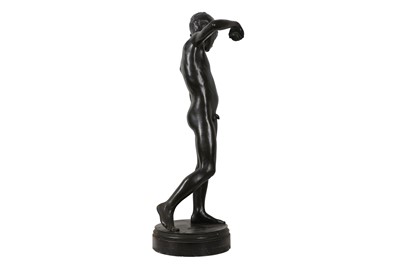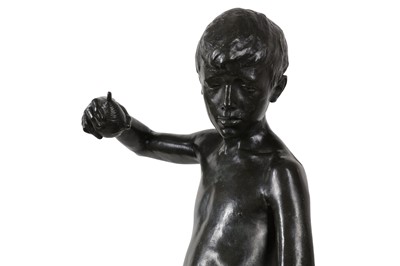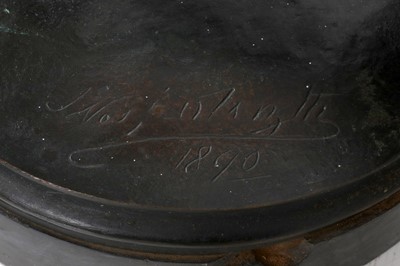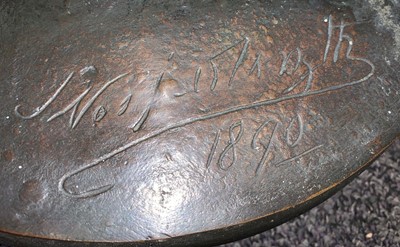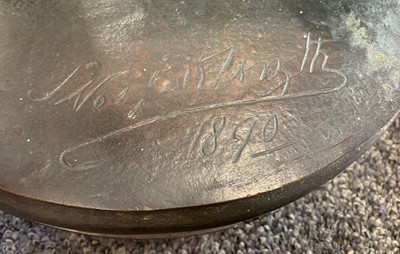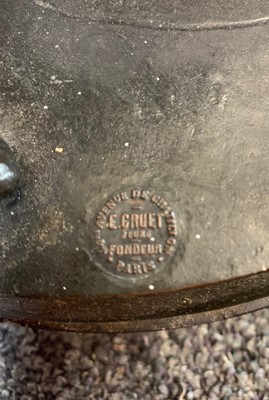29th Sep, 2020 14:00
Fine European Works of Art & Clocks
A LARGE LATE 19TH CENTURY PATINATED BRONZE FIGURE OF A BOY BY A FOLLOWER OF THE 'NEW SCULPTURE' SCHOOL
A LARGE LATE 19TH CENTURY PATINATED BRONZE FIGURE OF A BOY BY A FOLLOWER OF THE 'NEW SCULPTURE' SCHOOL by repute titled 'Garçon avec toupie' or 'Boy with spindle', modelled as a young nude boy in a contrapposto stance holding a yarn drop spindle in his outstretched hand, signed indistinctly to base and dated 1890, foundry stamp for E. Gruet Jeune of Paris (this stamp active circa 1891-1904) 'E.GRUET, JEUNE, FONDEUR, 44 bis AVENUE DE CHATILLON, PARIS', on a round black marble plinth base, 82cm high (including base)
This large and well cast bronze bears many of the defining features of the 'New Sculpture' School and in particular resembles the work of Sir William Goscombe John RA (Welsh 1860-1952). The facial expression and modelling of the limbs are strongly reminiscent of 'A Boy at Play' by Goscombe John dated circa 1895, now in the collection of the Tate. Although this sculpture predates it by five years it strongly demonstrates the qualities of the naturalistic representation of the body and the detailed rendering of its surface variations. It also embodies of the new 'ideal body type' as created by Goscombe John. Although it was cast in a French foundry, both British and French artists were casting in Paris during this time. This piece has been in a private collection for many years and is its first offering to the market in decades.
The term "New Sculpture" was coined by the first historian of the movement, the critic Edmund Gosse, who wrote a four-part series for The Art Journal in 1894. After a protracted period of a stylized neoclassicism, sculpture in the last quarter of the century began to explore a greater degree of naturalism and wider range of subject matter. The French sculptor Jules Dalou, in his eight-year English exile after the Paris Commune events in 1871, taught modelling at the South Kensington School of Art, and then at the Lambeth School of Art. He profoundly influenced a new generation of British sculptors, helping to usher in a new approach to the medium.
The catalyst for this development is usually understood to be the exhibition, in 1877, of Frederic Leighton's An Athlete Wrestling with a Python. This was Leighton's first major sculpture, and he intended it as a challenge to the prevailing styles of sculpture. It reflected his interest in a more dynamic and vibrant representation of the human body and a shift from easily legible and didactic subject matter. Many sculptors looked to the Athlete and created responses to it in the following years.
The New Sculpture represents an alternate formulation of a new direction for sculpture at the end of the nineteenth century. Whereas the major French alternative to mid-19th-century sculpture, Auguste Rodin, increasingly left the accurate representation of the human body behind, the New Sculptors by and large chose to grapple with issues arising from the naturalistic representation of the body and the detailed rendering of its surface variations. The New Sculpture does not represent one singular style, but rather a range of options developed to make sculpture more vital and lifelike.
Major figures associated with the New Sculpture school included the following artists, their pupils and those in their circles; C. J. Allen, Harry Bates, Gilbert Bayes, Sir Thomas Brock, Jules Dalou, Alfred Drury, Edward Onslow Ford, George Frampton, Alfred Gilbert, Goscombe John, Frederic Leighton, Andrea Carlo Lucchesi, Henry Albert Pegram, F.W. Pomeroy, James Havard Thomas, Hamo Thornycroft & Albert Toft.
Dimensions: 82cm
Do you have an item similar to the item above? If so please click the link below to request a free online valuation through our website.

